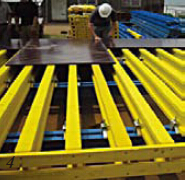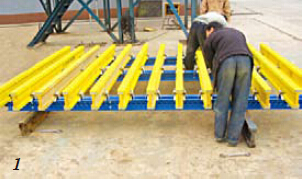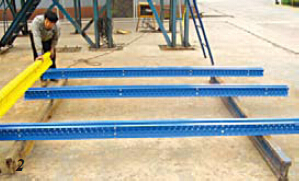Timber-beam Plywood Formwork for building Construction
- Loading Port:
- Tianjin
- Payment Terms:
- TT OR LC
- Min Order Qty:
- 50 m²
- Supply Capability:
- 1000 m²/month
OKorder Service Pledge
Quality Product, Order Online Tracking, Timely Delivery
OKorder Financial Service
Credit Rating, Credit Services, Credit Purchasing
You Might Also Like
Plywood --- make perfect concrete surface
WISA-Form Birch is a coated special plywood using in the formwork systems where high
requirements are set on the concrete surface and the times of reuses.
With CNBM timber beam & WISA plywood, the formwork is low weight but high load capacity, it is
widely used in construction.
Characteristics:
◆ Component with high standardization.
◆ Assembling in site, flexible application.
◆ Light weight, easy transportation and storage.



- Q:What are the different sizes and dimensions of steel formwork?
- Different construction requirements and project needs can be catered to by steel formwork, which is available in various sizes and dimensions. The typical sizes of steel formwork panels are 2 meters (6.5 feet) in height and 1 meter (3.2 feet) in width, although these measurements can differ depending on the manufacturer and specific project requirements. The thickness of steel formwork panels is usually between 12 to 14 millimeters (0.5 to 0.6 inches) to ensure they are strong enough to withstand the pressure exerted by the concrete during pouring and curing. Furthermore, steel formwork panels can be obtained in different lengths to accommodate varying wall heights and dimensions, ranging from 1 meter (3.2 feet) to 4 meters (13.1 feet) or even longer, depending on project specifications. In addition to panels, steel formwork systems consist of other components like beams, props, adjustable struts, and connectors. These components are available in different sizes and dimensions to provide support for the formwork structure and ensure stability and safety throughout the construction process. It is essential to keep in mind that the sizes and dimensions of steel formwork can vary based on the manufacturer, project specifications, and regional construction practices. Therefore, consulting with the manufacturer or a structural engineer is crucial to determine the appropriate sizes and dimensions of steel formwork required for a specific construction project.
- Q:What are the different types of formwork joints used in steel formwork?
- There are several types of formwork joints commonly used in steel formwork, including butt joints, lap joints, and tongue and groove joints. Butt joints involve aligning the edges of two formwork panels and securing them together with bolts or clamps. Lap joints involve overlapping two panels and securing them with bolts or clamps. Tongue and groove joints involve interlocking the edges of two panels, creating a tight and secure connection. Each type of joint has its own advantages and is used based on the specific requirements of the formwork project.
- Q:How does steel formwork accommodate openings and penetrations in the concrete?
- Steel formwork can accommodate openings and penetrations in the concrete by incorporating removable panels or cutouts in the formwork design. These panels can be easily removed or adjusted to create spaces for windows, doors, ducts, pipes, or any other required penetrations in the concrete structure. This flexibility allows for precise and efficient construction, ensuring that the concrete is poured accurately around the openings and penetrations, resulting in a well-structured and functional building.
- Q:How does steel formwork compare to plastic formwork?
- Construction projects commonly utilize two types of formwork systems: steel formwork and plastic formwork. These systems possess distinct advantages and disadvantages, making them suitable for varying applications. Steel formwork is renowned for its durability and strength, enabling it to withstand heavy loads. Consequently, it is ideal for large-scale projects that necessitate repetitive formwork usage. Compared to plastic formwork, steel formwork boasts a lengthier lifespan, rendering it a cost-effective choice in the long term. It can be effortlessly tailored to meet specific project requirements, thereby permitting design flexibility. Moreover, steel formwork yields a smooth concrete surface finish, reducing the need for supplementary finishing work. Conversely, plastic formwork surpasses steel formwork in several aspects. Its lightweight nature facilitates easy handling and transportation, leading to expedited installation and dismantling times, thereby enhancing overall project efficiency. Plastic formwork is also corrosion-resistant and does not necessitate surface treatment or maintenance. Being reusable and recyclable, it embodies an environmentally friendly option. Furthermore, it possesses commendable insulation properties, thereby facilitating energy consumption reduction in buildings. Regarding cost, steel formwork generally incurs higher upfront expenses due to elevated material and manufacturing costs. Nevertheless, the prolonged lifespan and reusability of steel formwork offset the initial expenditure, rendering it a cost-effective decision for projects involving substantial concrete pouring. In conclusion, the selection between steel formwork and plastic formwork hinges upon specific project requisites. Steel formwork proves suitable for large-scale ventures necessitating durability and strength, whereas plastic formwork is more apt for smaller projects mandating swift installation and dismantling. Both alternatives possess their own merits and demerits, necessitating careful consideration of factors such as cost, project timeline, and design flexibility when arriving at a decision.
- Q:How does steel formwork compare to timber formwork in terms of cost?
- Steel formwork generally tends to be more expensive than timber formwork in terms of upfront costs. This is primarily due to the higher cost of steel as compared to timber. Additionally, steel formwork often requires specialized equipment and skilled labor for assembly and disassembly, which can add to the overall cost. However, it is important to consider the long-term benefits and cost-effectiveness of steel formwork. While timber formwork may have a lower initial cost, it is more susceptible to wear and tear, especially in harsh weather conditions or when used repeatedly. Steel formwork, on the other hand, is highly durable and can be used for multiple construction projects, making it a cost-effective choice in the long run. Moreover, steel formwork offers greater precision and accuracy, resulting in better quality finishes and reduced rework. It also allows for faster construction due to its ease of assembly and disassembly, which can lead to significant time and labor savings, ultimately offsetting the higher upfront cost. In summary, while steel formwork may be more expensive initially, it offers durability, reusability, and higher productivity, making it a more cost-effective option in the long term compared to timber formwork.
- Q:Can steel formwork be used for projects with high groundwater levels?
- Yes, steel formwork can be used for projects with high groundwater levels. Steel formwork is known for its durability and resistance to water, making it suitable for construction projects in areas with high groundwater levels. Its robustness and waterproof properties allow it to withstand the pressure and moisture from the groundwater, ensuring the stability and integrity of the structure being built.
- Q:What are the common safety guidelines when working with steel formwork?
- The common safety guidelines when working with steel formwork include wearing personal protective equipment such as gloves, safety glasses, and hard hats, ensuring proper training and supervision for workers, inspecting the formwork for defects or damage before use, securing the formwork properly to prevent collapse or movement, using appropriate lifting and handling techniques to avoid strain or injuries, and following safe practices when working at heights or in confined spaces. It is also important to have emergency response procedures in place and to regularly communicate and reinforce safety protocols with all workers involved.
- Q:Are there any safety considerations when using steel formwork?
- Yes, there are several safety considerations when using steel formwork in construction projects. Firstly, handling and installing steel formwork panels can be physically demanding due to their weight and size. It is necessary to have proper lifting equipment and trained personnel to safely handle and position the formwork panels to prevent accidents or injuries. Secondly, steel formwork should be securely supported and braced to ensure stability during concrete pouring. Proper anchoring and shoring systems should be in place to prevent collapse or displacement of the formwork, which can lead to serious accidents. Additionally, working at heights while installing or removing steel formwork can pose a risk of falls. It is important to provide suitable fall protection measures such as guardrails, safety nets, or personal fall arrest systems to prevent workers from falling from elevated surfaces. Furthermore, steel formwork may have sharp edges or protruding parts that can cause lacerations or puncture wounds. Workers should be provided with appropriate personal protective equipment (PPE) such as gloves, safety boots, and eye protection to minimize the risk of injury. Moreover, steel formwork should be regularly inspected for any signs of damage or deterioration. Any damaged or weakened components should be replaced promptly to maintain the structural integrity and safety of the formwork system. Lastly, proper communication and coordination among workers is essential to prevent accidents. Clear instructions, training, and supervision are necessary to ensure that all workers understand and follow the safety procedures when using steel formwork. Overall, by adhering to these safety considerations and implementing appropriate safety measures, the risks associated with using steel formwork can be minimized, creating a safer working environment for construction personnel.
- Q:How does steel formwork affect the overall weight of the structure?
- Steel formwork can have a significant impact on the overall weight of a structure. Compared to traditional timber formwork, steel formwork is generally heavier due to the inherent properties of steel. Steel is denser and heavier than wood, which means that steel formwork will contribute more to the overall weight of the structure. However, the weight of the steel formwork can also be advantageous in certain situations. The increased weight of steel formwork can provide stability and rigidity to the structure during the construction process, ensuring that the concrete is properly supported and shaped. This can lead to a more precise and durable final structure. Moreover, steel formwork is typically more durable and can be reused multiple times, whereas timber formwork often needs to be replaced after a few uses. This can result in a reduced environmental impact and cost savings in the long run, even though steel formwork may initially add more weight to the structure. Ultimately, the effect of steel formwork on the overall weight of a structure depends on various factors such as the size and complexity of the project, the specific design requirements, and the construction method chosen. However, it is important to consider the trade-offs between the weight of the formwork and its benefits in terms of stability, durability, and cost-effectiveness.
- Q:How does steel formwork handle different concrete surface preparation techniques?
- Steel formwork proves to be a flexible and long-lasting solution for concrete construction endeavors, effortlessly accommodating diverse techniques for preparing concrete surfaces. Whether a sleek, blemish-free finish is desired or a rough texture is preferred, steel formwork can easily adapt. For achieving smooth finishes, steel formwork provides a sturdy and level surface, enabling precise leveling and alignment. The steel panels are meticulously designed to be seamless and flawless, guaranteeing a uniform concrete surface devoid of imperfections. This proves particularly advantageous for projects requiring a superior finish, such as architectural structures or decorative elements. Conversely, if a rough texture is the objective, steel formwork can effortlessly accommodate a variety of techniques to achieve the desired outcome. The formwork can be modified to incorporate patterns or textures such as wood grain or stone-like finishes, accomplished through the use of specialized liners or inserts. These liners can be affixed to the steel panels, imparting the desired texture onto the concrete surface. Furthermore, steel formwork adeptly handles other concrete surface preparation techniques such as shot blasting or acid etching. Shot blasting involves propelling steel balls onto the concrete surface, effectively eliminating contaminants and creating a rough texture. Acid etching entails the application of acidic solutions to the concrete, inducing a chemical reaction that eliminates a thin layer from the surface, thereby resulting in a textured finish. Steel formwork can withstand the impacts of shot blasting and the corrosive effects of acid etching without sustaining damage. Moreover, steel formwork offers remarkable adaptability, effortlessly customizable to meet specific project requirements. Should a particular surface preparation technique be necessary, the steel formwork can be designed accordingly to accommodate it. This versatility facilitates the achievement of a wide array of concrete surface finishes through the utilization of steel formwork. In conclusion, steel formwork is capable of accommodating various concrete surface preparation techniques, whether for smooth finishes, rough textures, or any other specific requirements. Its versatility, durability, and adaptability render it an exceptional choice for concrete construction projects that demand diverse surface finishes.
1. Manufacturer Overview |
|
|---|---|
| Location | |
| Year Established | |
| Annual Output Value | |
| Main Markets | |
| Company Certifications | |
2. Manufacturer Certificates |
|
|---|---|
| a) Certification Name | |
| Range | |
| Reference | |
| Validity Period | |
3. Manufacturer Capability |
|
|---|---|
| a)Trade Capacity | |
| Nearest Port | |
| Export Percentage | |
| No.of Employees in Trade Department | |
| Language Spoken: | |
| b)Factory Information | |
| Factory Size: | |
| No. of Production Lines | |
| Contract Manufacturing | |
| Product Price Range | |
Send your message to us
Timber-beam Plywood Formwork for building Construction
- Loading Port:
- Tianjin
- Payment Terms:
- TT OR LC
- Min Order Qty:
- 50 m²
- Supply Capability:
- 1000 m²/month
OKorder Service Pledge
Quality Product, Order Online Tracking, Timely Delivery
OKorder Financial Service
Credit Rating, Credit Services, Credit Purchasing
Similar products
New products
Hot products
Hot Searches
Related keywords






















